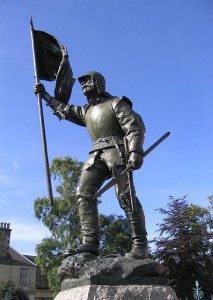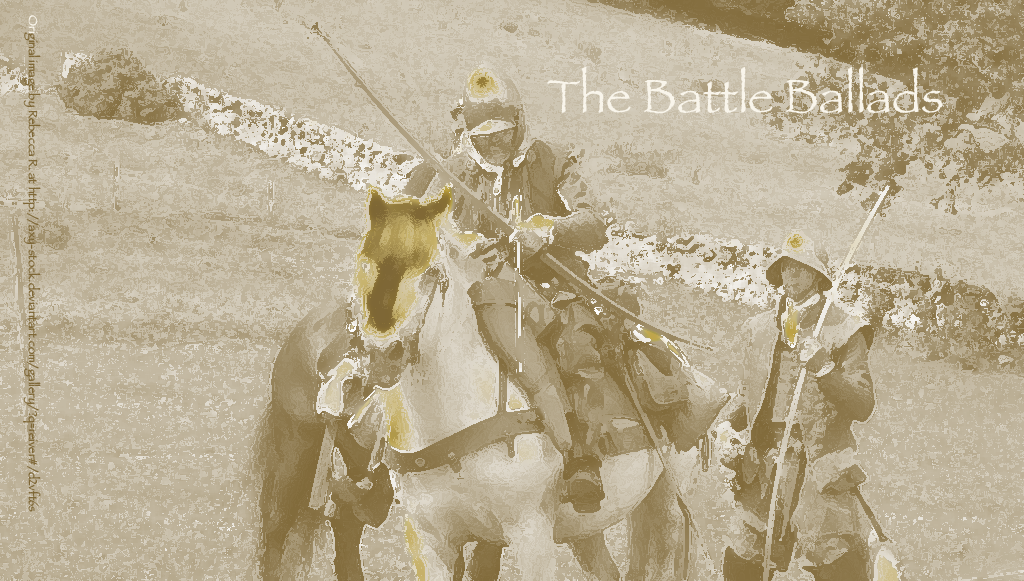The Flowers of the Forest
Two variants of “The Flowers of the Forest” were included in the 1802 edition of the Minstrelsy and remained throughout subsequent editions. The version we have included on this site is the one Scott identified as “Part I” in the index. Scott does not call this a ballad in his prefatory note and this may be due to the provenance of the piece. There was some debate over the lyrics – some people believed it to be a traditional piece, while others, including Robert Burns, had their doubts. Scott himself admits that he thought that it was a traditional song and that “it required the most positive evidence to convince the editors that the songs was of modern date. Such evidence, however, he has been able to procure” (MSB (1802) II 156). The author of this version was one Miss Jane Elliot. She was born in 1727 and died in 1805 at Mount Teviot, Roxburghshire.
The Battle of Flodden is not specifically identified in the song, but Scott states in the prefatory notes that “remembrance of the fatal battle of Flodden” was part of the inspiration for the song, along with a fragment of an old song and “the present solitary and desolate appearance of the country” (MSB (1802) II 157).
“The Flowers of the Forest” is very different from the other battle ballads we have included. It is an effective piece, focusing on the despair and sorrow of women, who have been left bereft of lovers and husbands due to the battle, rather than on the battle itself. As such, it is a lament, rather than a celebration, of a battle.
History
The Battle of Flodden was fought on the 9th September 1513, between the forces of King James IV of Scotland and those of King Henry VIII of England, although the Earl of Surrey led the English force, as the King was in France at the Seige of Thérouanne. The battle was a national disaster for Scotland. King James IV was killed on the battlefield and the losses among the nobility were catastrophic. Scotland’s noble houses lost twelve earls, thirteen barons, five heirs to Scottish titles, three bishops, and two abbots, as well as the King. Overall, it is estimated that at least 10000 Scots died.
The Scottish force had intially held the best, high ground, but they had to alter their position to meet with the English forces, who were positioned where they could best avoid the Scottish artiliary, the Scots were forced to descend to meet with the English, relinquishing the high ground and entering battle on uneven, marshy ground. Tactical failings, then, were one of the contributing factors in the defeat.
An account of the battle was presented in the English State Papers:
“Articles of the bataill betwix the K. of Scottes and therle of Surrey in Brankstone feld the 9 day of September.”
When the two armies were within three miles of each other Surrey challenged the King of Scots to battle, by Rugecross; who answered he would wait for him till Friday at noon. At eleven on 9 Sept. Howard passed the bridge of Twyssell with the vanguard and artillery, Surrey following with the rear. The army was divided into two battles, each with two wings. The Scotch army was divided into five battles, each a bowshot distant from the other, and all equally distant from the English, “in grete plumpes, part of them quadrant,” and some pikewise, and were on the top of the hill, being “a quarter of a mile from the foot thereof.” Howard caused the van to stale in a little valley till the rear joined one of the wings of his battle; then both advanced in line against the Scots, who came down the hill, and met them “in good order, after the Almayns manner, without speaking a word.” Earls of Huntley, Eroll, and Crawford met Howard with 6,000 men, but were soon put to flight, and most of them slain. The King of Scots with a great power attacked Surrey, who had Lord Darcy's son on his left. These two bore the brunt of the battle. James was slain within a spear's length of Surrey; many noblemen with him; no prisoners taken. At the same time, Lennox and Argyle joined battle with Sir Edward Stanley, and were put to flight. Edmund Howard was on the right wing of Lord Howard with 1,000 Cheshire and 500 Lancashire men, and many gentlemen of Yorkshire, who were defeated by the Lord Chamberlain of Scotland (Alex. lord Hume). Mr. Gray and Sir Humphrey Lyle are taken prisoners, Sir Wynchard Harbottle and Maurice Barkley slain; Edm. Howard was thrice “feled,” when Dacre came to his relief and routed the Scots, after having eight score of his men slain. The battle began between 4 and 5 in the afternoon, and the chase was continued three miles with great slaughter; 10,000 more would have been slain if the English had been horsed.
The Scots were 80,000, of whom 10,000 were killed; the English lost only 400. [“The Borders not only stale away as they lost 4 or 5,000 horses, but also they took away the oxen that drew the ordnance, and came to the pavilions and took away all the stuff therein, and killed many that kept the same.” ] The English and Scotch ordnance has been conveyed, by the help of Dacre, to Etall Castle. The King of Scots' body is brought to Berwick. No great man of Scotland has returned, except the Chamberlain.
The remarks in square brackets are scored out in the original letter.
A letter sent by James V to the King of Denmark, looking for support for Scotland, sets out the precarious state Scotland was believed to have been in.
Instructions for Andrew Brounhill, sent by James V. to the King of Denmark, 16 Jan. 1513.
To remind him of what Magnus Beild was charged to tell his uncle by James IV. (No. 1564) viz., that the English had broken the treaty, wasted his lands, &c., but notwithstanding he had for many years kept the peace, disliking to take up arms against a Christian. When the English were invading France he asked the King in a friendly way to desist from harassing his ally and relation, fearing that after conquering that country he would turn his arms against Scotland. At this the King of England swore not to cease from war until he had taken the life and kingdom of the Scots, or lost his own. Angry at this, he hastily collected an army and invaded England, taking several castles, but, rashly engaging the English army, fell in battle (described), with most of his nobles, losing all the baggage and artillery. Many more, however, of the enemy were killed; but their chief men all escaped, being posted in the reserves and rear. The King of England, elated by this victory, threatens to destroy Scotland. The King of France has promised to send assistance in the spring. Trusts that Denmark will do the same. A French ambassador is also sent for the same purpose. Brownhill is to show what danger Scotland is in, that soon assistance will be too late, and to allow him to make his own terms. To send word as soon as possible, what assistance will be sent. To remind him of his desire for the marriage with the cousin of the French King, of the House of Boulogne. De la Basty will show the terms for the marriage, &c. (R. MS. 13 B. II. 82 (No. 225). B.M. Ep. Reg. Sc. I. 186.)
What happened to the Scottish King himself was the source of legend and speculation. His bloodied surcoat and gauntlets were sent to Henry VIII by his Queen, and it was believed that his body was taken to London and embalmed, with the intention of burial, which never seemed to have taken place. This body was lost for years, but there was a claim by the English historian John Stow that he had seen the body – with the head separated from it through neglect and misuse, and that the head at least been interred in St Michael's, Wood Street, London. The fact that the body taken to London did not have an iron chain around its waist – James IV wore a chain as an act of religious penance – excited speculation that it could not be the king. There were some tales that said he had escaped the battlefield, others which claimed that his body had been rescued from the field and given a secret burial. In the 17th and 18th centuries, there were several accounts of a skeleton being discovered with a chain around its waist. These claims were associated with different Border locations, castles and houses, but there is no definitive source to say what exactly happened to the body of King James IV.
 On a local, Borders, level, many of the Border towns and villages provided men at arms, and consequently, the adult male population of these places was almost wiped out. In Selkirk, the Fletcher Statue commemorates the town’s sole survivor from the 80 men who went to Flodden: he is shown with a captured English banner in one hand and his halbert in the other. It is said that when he reached Selkirk, he could not speak for exhaustion, grief and despair, but only cast the banner round his head, then laid it on the ground.
On a local, Borders, level, many of the Border towns and villages provided men at arms, and consequently, the adult male population of these places was almost wiped out. In Selkirk, the Fletcher Statue commemorates the town’s sole survivor from the 80 men who went to Flodden: he is shown with a captured English banner in one hand and his halbert in the other. It is said that when he reached Selkirk, he could not speak for exhaustion, grief and despair, but only cast the banner round his head, then laid it on the ground.
The battle was fought on the land near to the English village of Branxton, and for this reasons, the battle also known as the Battle of Branxton Moor, particularly in England. The presumed location of the battlefield has been moved since Scott's time, thanks modern archaeological research and digs.
You can read more about the battle on the Battlefield Trust site and also on the Remembering Flodden site.
_______________________________________________________
Flodden Panorama image information:
© Copyright Andrew Curtis and licensed for reuse under this Creative Commons Licence.
Fletcher Statue image information:
© Copyright Walter Baxter and licensed for reuse under this Creative Commons Licence.

